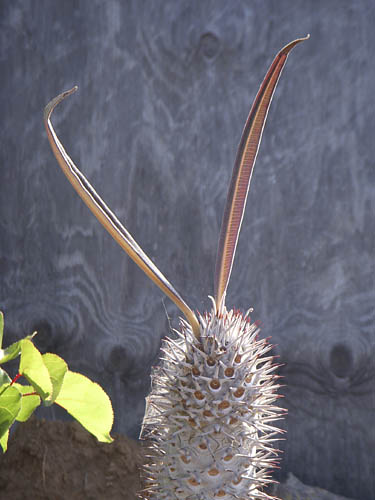The evidence!
Okay, okay, I’ll admit it. Despite a certain resemblance to the classic “Martian popping thing” available at Archie McPhee’s, it’s actually the final two leaves on a Pachypodium geayi, a succulent and spiny first-cousin to the better known plumeria that is such a fragrant staple in Hawaiian leis.
 Kept moist, and during the cooler and wetter parts of the year, the plant is a spiny column ringed with a rosette of long gray-green leaves. Drop the watering, and the plant goes into defensive mode, dropping its leaves and making like a cactus. Where we have it, in the back of the back yard, it gets to dry out along with the rest of the drought-tolerant plants, so we get to see its “cactus” behavior most of the summer and into fall. When the water starts up, the leaves come back and it’s happy again.
Kept moist, and during the cooler and wetter parts of the year, the plant is a spiny column ringed with a rosette of long gray-green leaves. Drop the watering, and the plant goes into defensive mode, dropping its leaves and making like a cactus. Where we have it, in the back of the back yard, it gets to dry out along with the rest of the drought-tolerant plants, so we get to see its “cactus” behavior most of the summer and into fall. When the water starts up, the leaves come back and it’s happy again.
This species can produce pendant cream-colored flowers with reflexed petals. They’re not the most spectacular bloomers in the Pachypodium genus–P. lamerei could be confused for a plumeria if it weren’t for the spines on the plant.
This plant is about ten years in the ground and is coming up on four feet tall. Mature plants will get triple or quadruple the height of this teenager. More water would help it along, I’m sure, but in my yard it gets what it gets.
So far no pests have bothered it. Would you?

